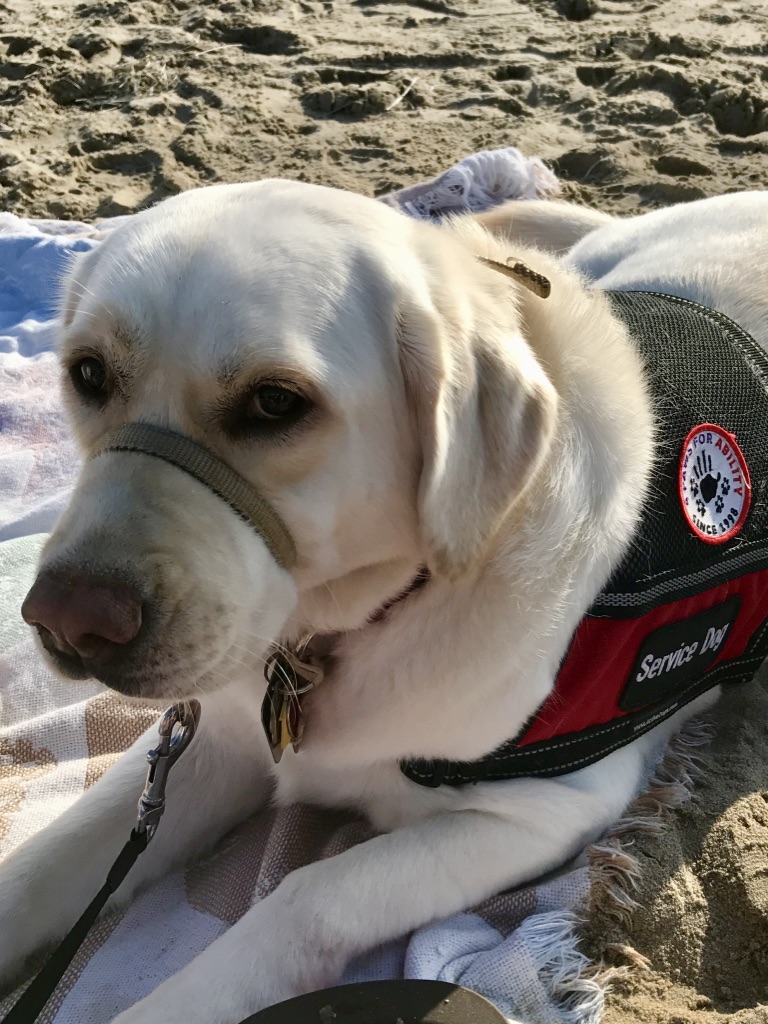We may earn money or products from the companies mentioned in this post.
Guide Dogs and Service Dogs
(This post is based on my personal experience with one service dog agency and observations at one Guide Dog agency). I had the opportunity to attend a Guide Dogs of America (GDA) graduation ceremony and tour their facilities in Sylmar California. I am a trained handler for my daughter’s service dog (a three-unit team) and supervise my son while he is handling his service dog in public. These are the differences between service and guide dogs.

Guide Dogs
The guide dog graduation ceremony was as emotional and heartwarming as the ceremonies my family participated in when we completed training for Ned and Raven, our service dogs. I was surrounded by puppies of all ages and stages of training. They were decked out in training vests to attend the graduation ceremony with their puppy raisers.
The folks that volunteer to raise service and guide dog puppies are incredibly devoted and special. They are patient and consistent with their little charges. It is an emotional experience for recipients to meet the family that gave their pup a great foundation. The auditorium was packed with people and dogs.
Each graduate and guide dog team was introduced along with their puppy raiser. Their stories were compelling as they filled the room with love. The guide dog puppy raisers spend over a year teaching their puppy. Most of the families were overwhelmed with emotions as they observed their puppy all grown up and working with their human.

Training
Once the puppies are 8 weeks old, GDA places them with a puppy raiser family. In order to prepare the puppy for their first car ride, they are pulled around in wagons on bumpy and smooth surfaces to help them acclimate to movement and prevent motion sickness. The trainers think of everything! The puppies remain with their family until they are sixteen to eighteen months old.
The families teach their puppies obedience and house manners. They also socialize the puppies in all things urban environments. When the puppies return to GDA they learn guide dog skills for four to six months. All guide dogs in training learn the same advanced skills.
Guide Dog Breeds
GDA primarily uses Labrador Retrievers. They also use mixed-breed Golden/Labradors and German Shepherds. Guide dogs are commonly referred to as the Navy Seals of working dogs or the cream of the crop. Their mission is to assist visually impaired adults to safely navigate their community. They are truly extraordinary dogs.
Field Trips
Throughout their stay with their family, the puppies periodically visit the GDA facility to become acclimated to the kennel environment. Planned kennel stays help avoid the shock of this very different environment when the dog returns for advanced training. At any given time, GDA has up to fifty dogs trained and ready to be placed. A training class consists of nine teams.
Important Training Difference
One big difference between service dogs and guide dogs is intelligent disobedience training. A dog’s point of view is typically at a human’s waist level. Guide dogs are taught to broaden their view to look up to watch for obstructions such as tree branches or overhead danger. Guide dogs also look down to the ground for grates and curbs.
The dogs learn that despite a command to walk forward or go left/right if there is an obstruction they will stop to alert their human to the danger. Service dog handlers can see obstructions and move the dog around them.
Miracles on Paws
My family received our service dogs from 4 Paws for Ability (4 Paws) in Xenia, Ohio. Dogs that work with humans are miracles on four paws. The basics are similar, such as the breeds used and puppy raising. Support from the programs to the recipients is unwavering and always available.
Both facilities that I visited (OH and CA) are beautiful and state-of-the-art. Their human’s lives change dramatically, especially the first-time recipients. Both agencies have their own in-house breeding programs. Dedicated families have the privilege of raising specially selected pups who will breed future service dogs and guide dogs.
Service Dogs
Service dog puppies with 4 Paws spend their first eight weeks in the Puppy Enrichment Program. Our service dog Ned went to prison after puppy enrichment to participate in the Mission Pawsible program. The inmates taught him obedience.
After Mission Pawsible, Ned lived with a puppy raiser family. He returned to 4 Paws at approximately nine months old to begin his advanced training. Advanced training teaches service dogs the tasks and commands they need to know in order to assist a specifically assigned client.
A task can be trained in multiple ways. For example, barking is used to alert parents that the service dog has detected seizure scent, high and low blood sugar, or that a child with autism has escaped from the home. While a child with type 1 diabetes is in school, the dog might be trained to paw the child instead of barking when blood sugar is climbing or dropping. Pawing is less disruptive in the classroom.
The task “over” is used to help children with sensory processing challenges. The dog climbs over the child’s legs when they are seated on the floor or in bed. The weight of the dog acts as a weighted blanket and promotes calming. My daughter did not like having Ned sit on her legs. She prefers to lay on her stomach and have Ned lay over her back or her knees. This modification was made during our training.
Service Dog – Raven
Raven, our second service dog went from Puppy Enrichment to college to live with a student in their dorm. The student taught obedience and socialized her around campus. Raven went on to live with two different puppy raiser families. Raven was twenty months old when she joined our family.

Types of Service Dogs
4 Paws provides service dogs to children and veterans of recent conflicts. 4 Paws is currently training the following types of service dogs:
Autism Assistance Dog
Diabetic Alert Dog
FASD Assistance Dog
Facilitated Guide Work (dog, child, parent handler)
Hearing Ear Dog
Mobility Assistance Dog
Multipurpose Assistance Dog
Seizure Assistance Dog
Veteran’s Assistance Dog
4 Paws also recently began training Alzheimer’s Assistance dogs. The skills to assist adults with Alzheimer’s are similar to children with Autism. The combination of skills that service dogs are trained to perform is endless. Examples of skills taught are search and rescue, behavior disruption, tethering, item retrieval, sound alert (a doorbell), and scent work (diabetes and seizures).

Service Dog Breeds
The most common 4 Paws service dog breeds are Golden Retrievers, Labrador Retrievers, Standard Poodles, German Shepherds, golden/labs, and Goldendoodles. They also train Papillons for scent work. Their tiny noses are incredible at detecting seizures and high/low blood sugar.
Qualifications
In order to qualify for a GDA guide dog, an applicant must be visually impaired/legally blind. The minimum age is 18. There is no maximum age limit. The applicant must be capable of providing all of the care for the dog themselves and have full mobility. There is no cost for the expenses of the dog. Transportation to California is included.
4 Paws does not require a disability to be a specific level of severity. If a family feels a service dog will help their child and they can care for the dog, 4 Paws requires verification of the disability from a physician. There is no minimum age because the caregiver is the handler in most cases. Older children who do not have developmental disabilities can sometimes handle their own dogs.
Families fundraise for their share of the cost (fee-for-service) and pay for their travel expenses. Veterans are the exception. There are Veteran’s programs that fundraise for them. Some families also receive support from non-profits associated with their child’s disability or for seriously ill children (Make-A-Wish).
Recipient Training
Recipients of a guide dog spend twenty-one days living on the GDA campus. The recipient begins with Juno – a simulated walk where the recipient holds an empty harness and a trainer guides them (acting as the dog). Dogs and recipients meet on the third day of training.
The teams visit Pasadena, a City near Sylmar, to learn how to navigate X-style crosswalks, train platforms, and riding trains, and buses. The teams will also complete an all-day scavenger hunt in a mall.
4 Paws require a child to be accompanied to training by two adults. One adult will attend training at all times. It is difficult for some children to remain on site all day and some children need care at all times. The second adult is there primarily to attend to the child.
Training takes place for twelve days straight and the client meets their dog on the first day. Families stay in local area hotels. The dogs join them at the hotel on day three.
Training takes place at the 4 Paws facility and in a local mall. Search and rescue teams practice in local parks. The handler must pass a public access test a the end of the training.
Health Guidelines
A guide dog must be in perfect health to reach advanced training. Their hips and elbows are x-rayed twice to ensure there is no dysplasia. Temperaments are tested. The dog must be willing and enthusiastic to perform their incredibly important job.
If a puppy does not meet all of these qualifications, the puppy raiser is given the first choice to adopt the dog. Many of the dogs don’t meet Navy Seals standards but they will make excellent service dogs. GDA works with Veterans and Autism service dog programs to place these career changers.
Service dogs must also be in excellent health. Every puppy is examined frequently by the Veterinarian at 4 Paws. Temperament is also important but different for each match. Dog temperaments differ based on the tasks the dog will perform and the temperament of the child or veteran receiving them.


The Magic of the Match
The recipients of these amazing service and guide dogs believe that magic plays a role in determining the match. Our match was a huge Goldendoodle. The match letter and pictures arrived shortly before our trip to Ohio. I am short and we live in an apartment in a city.
I took one look at Ned’s photo and cried. How was I going to manage and control such a big dog and my child in public? It took about two days of training to realize he was, in fact, the perfect match. Ned is easy to handle because he is so mellow and compliant. The lead trainer and his staff are dog whisperers who use their magic to figure out which dog is meant for each client.


How You Can Help
4 Paws and GDA continuously recruit families who are willing to raise and love dogs for their breeding program and for puppy raisers. Both agencies have numerous giving opportunities including cash donations and planned giving. 4 Paws donors can also help a family with their fundraising.
Both agencies have shops on-site and online. Both agencies rely on volunteers. There are opportunities to be involved from clerical, nursery care, dog baths, tour guide, marketing, and publicity to community events.
Guide dogs and service dogs are noble animals that save lives, expand a recipient’s world, are incredibly smart, and provide unconditional love. Our two incredible dogs in our family help my children in ways beyond measure. I am in awe when I encounter a guide dog team in our community and travel.
Please teach your children to NEVER approach, distract or pet a working dog. There is much to admire about these dogs but please do so from a distance.
You May Also Enjoy:




